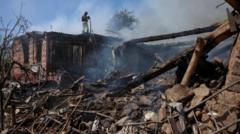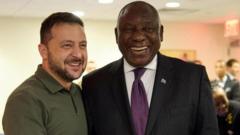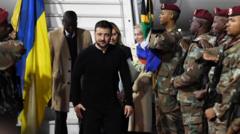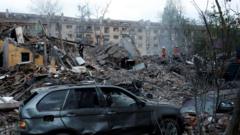As high-stakes diplomatic negotiations unfold, the US is intensifying initiatives to bring an end to the ongoing war in Ukraine. Recent talks in London, involving officials from the UK, Germany, France, Ukraine, and the United States, signify a concerted effort to address the conflict. Simultaneously, Donald Trump's special envoy, Steve Witkoff, prepares for another meeting with President Putin in Moscow, marking his fourth visit in pursuit of peace. However, ambiguity surrounds the prospects of these endeavors as competing demands from the involved parties emerge.
### US Pushes for Peace in Ukraine Amid Uncertain Futures

### US Pushes for Peace in Ukraine Amid Uncertain Futures
The United States ramps up diplomatic efforts to resolve the Ukraine conflict, navigating complex conditions and diverging priorities among involved nations.
Previously, the American strategy was straightforward: an immediate, unconditional 30-day ceasefire followed by discussions to create a lasting resolution to the conflict. Although Ukraine expressed willingness to agree to this plan—sacrificing its long-standing requirement for security guarantees—the situation quickly grew complicated. Russia, under Putin's leadership, refused to cease hostilities unless a series of its demands were met; predominantly, the need to address its perceived threats from NATO expansion and the independence of Ukraine.
The negotiations have hinted at a potential framework suggesting that Russia would pause its military advances while relinquishing aspirations of controlling remaining territories in eastern Ukraine—specifically Luhansk, Donetsk, Zaporizhzhia, and Kherson. In exchange, the US might recognize these regions as Russian-controlled, alongside acknowledging Crimea as part of Russia’s territory, an act stemming from its illegal annexation in 2014. Additionally, the proposal might include stipulations preventing Ukraine from seeking NATO membership and strategically managing the Zaporizhzhia nuclear power plant.
Despite these concessions, the likelihood of success seems bleak. President Zelensky has firmly stated that Ukraine will not accept Crimea's status as Russian sovereign territory. Given the necessity of public support, a national referendum would be needed to even consider such a move, complicating matters further. European allies have echoed this sentiment, highlighting their refusal to tolerate any shifts of sovereignty that compromise international law.
Legal ambiguities regarding US recognition of Crimea complicate matters further, indicating significant legislative hurdles. However, some diplomats remain cautiously optimistic, suggesting that there may indeed be opportunities for dialogue if trust can be established among the parties involved.
Yet, many critical issues remain unresolved within the leaked details of the proposed agreements. There is uncertainty regarding restrictions on Western rearmament of Ukraine, a demand long emphasized by Russia, and a lack of consensus on Ukraine’s military size—another contentious point for Moscow. Although Ukraine would forego NATO membership, joining the European Union remains a potential pathway, which might include protections from a European reassurance force stationed in Western Ukraine to deter future aggressions.
The current dynamics reflect a complex standoff where both the U.S. and Ukraine seek swift resolutions, while Russia demands extensive peace negotiations that typically require extensive time to conclude. The sentiment encapsulated by the Russian saying, "nothing is agreed until everything is agreed," underscores the distance yet to be traversed by the involved nations towards establishing a lasting peace in Ukraine.
The negotiations have hinted at a potential framework suggesting that Russia would pause its military advances while relinquishing aspirations of controlling remaining territories in eastern Ukraine—specifically Luhansk, Donetsk, Zaporizhzhia, and Kherson. In exchange, the US might recognize these regions as Russian-controlled, alongside acknowledging Crimea as part of Russia’s territory, an act stemming from its illegal annexation in 2014. Additionally, the proposal might include stipulations preventing Ukraine from seeking NATO membership and strategically managing the Zaporizhzhia nuclear power plant.
Despite these concessions, the likelihood of success seems bleak. President Zelensky has firmly stated that Ukraine will not accept Crimea's status as Russian sovereign territory. Given the necessity of public support, a national referendum would be needed to even consider such a move, complicating matters further. European allies have echoed this sentiment, highlighting their refusal to tolerate any shifts of sovereignty that compromise international law.
Legal ambiguities regarding US recognition of Crimea complicate matters further, indicating significant legislative hurdles. However, some diplomats remain cautiously optimistic, suggesting that there may indeed be opportunities for dialogue if trust can be established among the parties involved.
Yet, many critical issues remain unresolved within the leaked details of the proposed agreements. There is uncertainty regarding restrictions on Western rearmament of Ukraine, a demand long emphasized by Russia, and a lack of consensus on Ukraine’s military size—another contentious point for Moscow. Although Ukraine would forego NATO membership, joining the European Union remains a potential pathway, which might include protections from a European reassurance force stationed in Western Ukraine to deter future aggressions.
The current dynamics reflect a complex standoff where both the U.S. and Ukraine seek swift resolutions, while Russia demands extensive peace negotiations that typically require extensive time to conclude. The sentiment encapsulated by the Russian saying, "nothing is agreed until everything is agreed," underscores the distance yet to be traversed by the involved nations towards establishing a lasting peace in Ukraine.




















